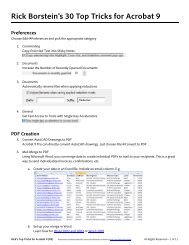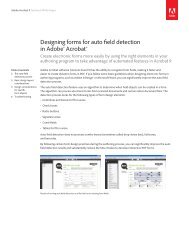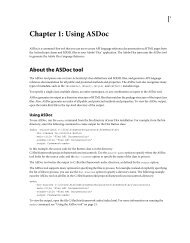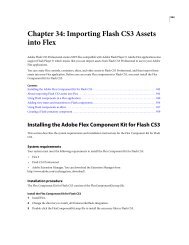Using Adobe® Flex® 4 - Adobe Blogs
Using Adobe® Flex® 4 - Adobe Blogs
Using Adobe® Flex® 4 - Adobe Blogs
- TAGS
- using
- adobe
- blogs
- blogs.adobe.com
You also want an ePaper? Increase the reach of your titles
YUMPU automatically turns print PDFs into web optimized ePapers that Google loves.
USING FLEX 4<br />
Fonts<br />
You can also embed fonts in ActionScript by using the [Embed] metadata tag. As with the @font-face declaration,<br />
you must specify a separate [Embed] tag for each font face.<br />
Note: Check your font licenses before embedding any font files in your Flex applications. Fonts might have licensing<br />
restrictions that preclude them from being stored as vector information.<br />
If you attempt to embed a font that the Flex compiler cannot find, Flex throws an error and your application does not<br />
compile.<br />
Embedded font syntax<br />
[Chunk: No] [Output: IPH, Print, Web] [EditorialStatus: Preliminary Review]<br />
To embed TrueType or OpenType fonts, you use the following syntax in your style sheet or tag:<br />
@font-face {<br />
src: url("location");<br />
fontFamily: alias;<br />
[fontStyle: normal | italic | oblique] ;<br />
[fontWeight: normal | bold | heavy] ;<br />
[advancedAntiAliasing: true | false];<br />
[embedAsCFF:true|false] ;<br />
}<br />
The src property specifies the location and filename of the font.<br />
The fontFamily property sets the alias for the font that you use to apply the font in style sheets. This property is<br />
required. If you embed a font with a family name that matches the family name of a system font, the Flex compiler<br />
gives you a warning. You can disable this warning by setting the show-shadows-system-font-warnings compiler<br />
option to false.<br />
The fontStyle and fontWeight properties set the type face values for the font. These properties are optional, unless<br />
you are embedding a face that requires them. The default values are normal.<br />
The advancedAntiAliasing property determines whether to include the advanced anti-aliasing information when<br />
embedding the font. This property is optional. This property is ignored if you embed a font with the embedAsCFF<br />
property set to true. You cannot use this option when embedding fonts from a SWF file (see Embedding fonts from<br />
SWF files). For more information on using advanced anti-aliasing, see “<strong>Using</strong> advanced anti-aliasing with non-CFF<br />
based fonts” on page 9.<br />
The embedAsCFF (Compact Font Format) property indicates whether to embed an FTE-enabled font for components.<br />
Flash Text Engine (FTE) is a library that provides text controls with a rich set of formatting options.<br />
If you set the embedAsCFF property to true, then the embedded font will let you use the advanced formatting features<br />
of FTE such as bidirectional text, kerning, and ligatures. If you set the value of embedAsCFF to false, then the<br />
embedded font will not support FTE, and will work only with the Halo text components. If you use Halo text<br />
components in Flex 4 application, you might need to embed the same font multiple times (once with embedAsCFF set<br />
to true and once with embedAsCFF set to false). The default value is true. Alternatively, you can use FTE-based<br />
classes for text rendering in your Halo text controls. For more information, see “Embedding fonts with Halo<br />
components” on page 24.<br />
The following example embeds the MyriadWebPro.ttf font file:<br />
@font-face {<br />
src: url("../assets/MyriadWebPro.ttf");<br />
fontFamily: myFontFamily;<br />
embedAsCFF: true;<br />
}<br />
5











